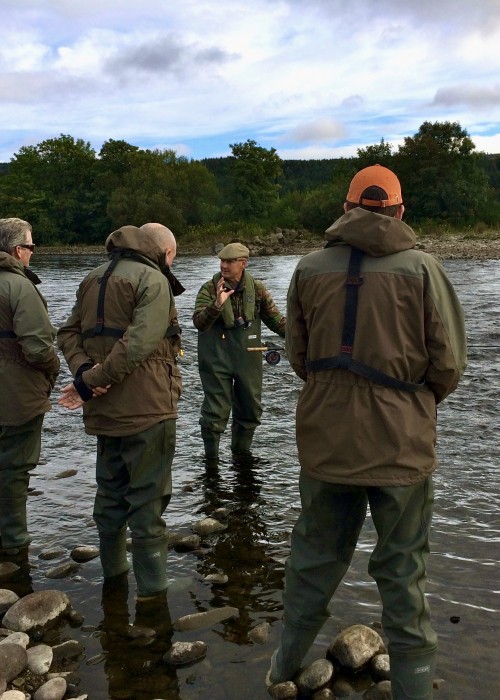
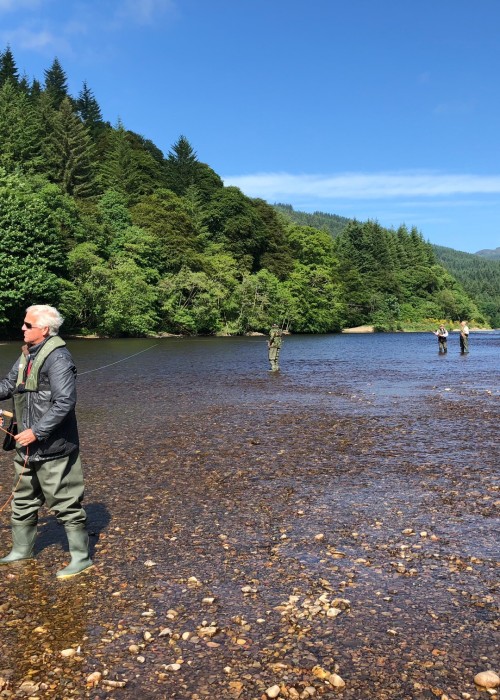

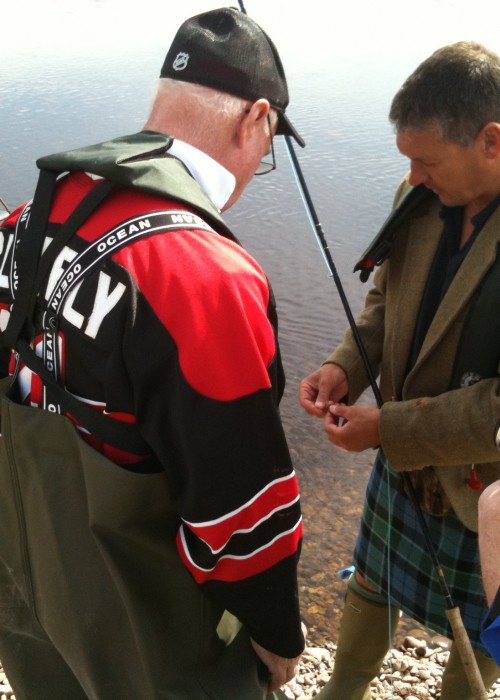
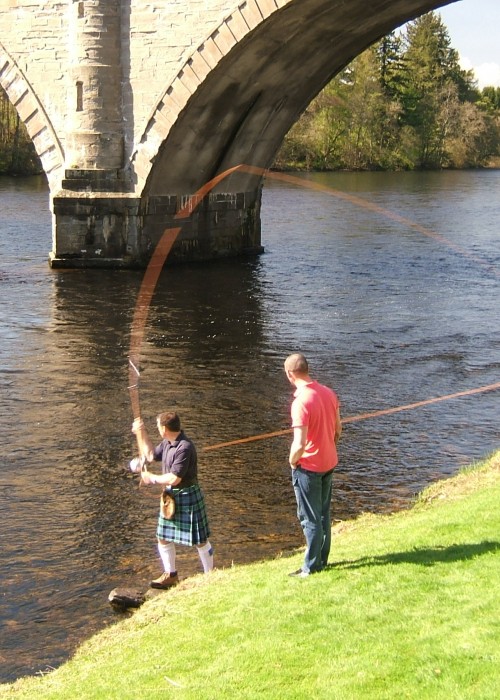
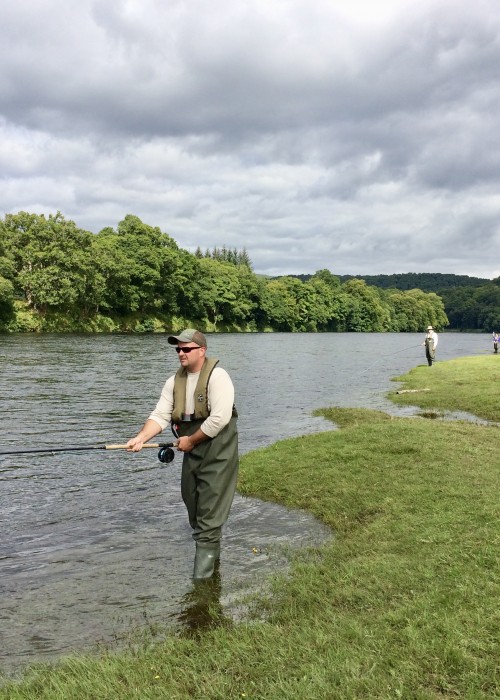
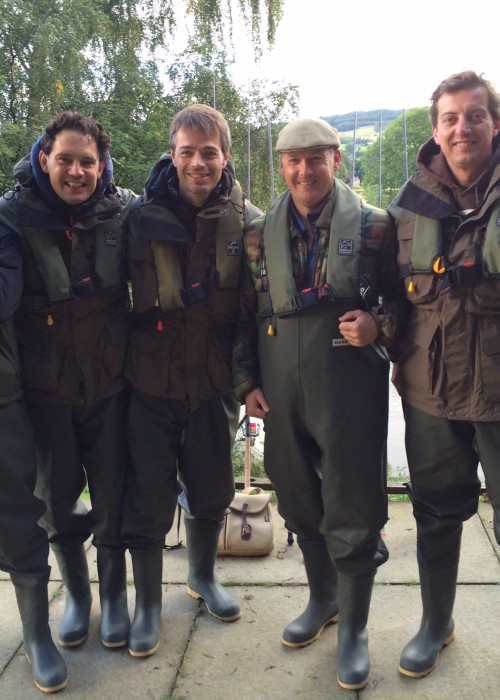
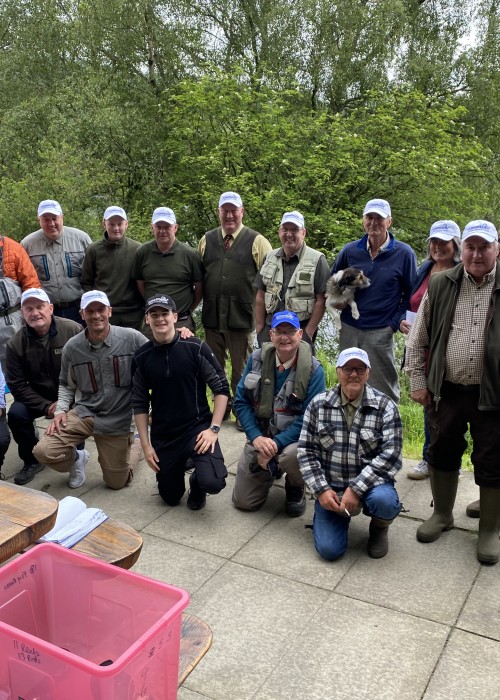
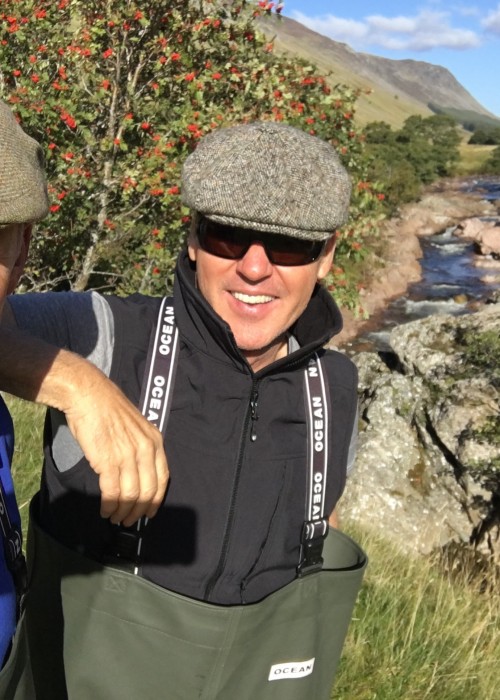
There's nothing that beats the perfect scenery and ambiance of the Scottish salmon rivers as a classroom for learning how to be effective at catching salmon.
There's nothing that beats the perfect scenery and ambiance of the Scottish salmon rivers as a classroom for learning how to be effective at catching salmon. A guided Scottish salmon fishing experience makes the perfect introduction to this fine pursuit and will provide all of the necessary salmon fishing equipment along with a professional salmon guide to make sure you pick up all of the required salmon fishing skills.
For the smaller fishing groups with less time for their salmon fishing trip look to the bigger Scottish salmon rivers like the River Tay, River Dee, River Spey & River Tweed. These are referred to as the ‘big four’ and due to their sheer size accessibility is always going to be easier and in most cases readily available for single party fishing trips or smaller groups who wish to salmon fish for only a few days. These big four have good runs of salmon through the Spring, Summer & Autumn months and always have sufficient water in them to hold fish and are always accessible even through the busy fishing periods of the Scottish salmon fishing season. If you’ve limited salmon fishing time and don’t want a possible scenario where you’re stuck on a Scottish river where there’s no water and no fish then keep to the bigger Scottish salmon rivers I’ve mentioned above.
Scottish salmon fishing requires patience with good water coverage consistency along with some reasonably well understood fishing techniques. The best mental approach to Scottish salmon fishing is to switch off the salmon urgency thoughts in your head and relax, breath in the fresh Scottish air and take in the perfect riverbank scenery. Settle yourself into an advanced state of riverbank relaxation and enjoy your water coverage skills as you're working your way through the various salmon pools. It is usually always when you're in this relaxed frame of mind that a salmon will co-operate.
The most important elements for an instructor to be able to teach Spey casting effectively are firstly having a solid grip of the logic and mechanics of the cast and secondly being a great communicator. Technical jargon only baffles students so easy to understand simple words like 'smoothness & fluency' through the lift and swing permits the student a much shorter learning curve. Really this is the easiest cast or all to perfect if you've a good instructor by your side who's talking logic backed sense to you.
Wading too deep is a common fault in salmon fishing as a pool gets easily spooked by an angler moving too close to the the salmon lies. In addition to this the angler is more likely to stumble and get wet if he’s wading through a pool too deeply. Train your feet become your hands as you feel your way along the riverbed and do not to commit your body weight to the next step until your are certain of a firm footing. Use a wading stick to assist where you cannot see the riverbed clearly & polaroid glasses will help you to see through the water's surface glare and also protect your eyes from the fast moving salmon fly. In faster streams you can reduce the water pressure on both legs by wading sideways (facing the far bank) down the pool where the water pressure is on one leg instead of both legs (which would be the case if you were only facing downstream).
Be aware that there’s always a deep pocket on the riverbed directly downstream of all biggish stones so never step over a big riverbed stone but always wade around it carefully on the inside edge. During most salmon fishing conditions shin to knee depth is about the optimal depth for wading while fishing. Always wear a pre-serviced automatic life preserver for your own personal fishing safety when on or near the river. Our guided salmon fishing service provides a life jacket for every guest which is mandatory for all guests. These automatic life jackets do not interfere with mobility for casting in any way and could save your life.
One of the biggest errors in Scottish salmon fishing I see is from salmon fishers not moving through the salmon pools effectively. Often if a salmon shows itself the reaction of many salmon anglers is to slowly fish over the salmon or even stop and consistently present your fly to the salmon's position in the pool. All this does is condition the fish to accept the fly to a point where it will ignore the fly no matter how hard you try to make it take. If a salmon wants your fly then rest assured that it will come and attack the fly. These fish are seriously efficient predators in the sea and when they are in the correct frame of mind (assuming your approach is correct) then they will not miss your fly. The take from a salmon normally comes on the initial swing of the fly which places the fly on a flight path near the salmon. If the desired reaction isn't obtained at that point it is best to keep fishing through the pool and come back for another go later as showing a salmon too much of the salmon fly is definitely not a good thing to do.
The best movement to deploy when fly fishing for salmon is to move 3 feet downstream between each swing of the fly (as mentioned below). This fly swing spacing is crucial for effective water coverage and for not showing resident salmon too much of the fly. The mindset to adopt on this subject is to imagine the reaction you'd get from a kitten if you threw a table tennis ball in its general direction. The first time the cat saw the moving ball would generate the biggest reaction before the cat quickly lost interest and ignored the ball completely. What you want to do is startle a salmon and good swing spacings doesn't let the fish see the fly coming (or too much of the fly). If all of a sudden your fly is visible in front of the salmon that's the moment a reaction in the form of a solid take is most likely to occur. Moving consistently 3 ft between cast will amount to loads of effective water coverage throughout the course of the fishing day too so this effective water coverage logically will also stand you the best chance of seeking out a taking salmon wherever that fish is located on the salmon fishing venue.
Having served as a professional Scottish ghillie on 2 high profile River Tay salmon beats I’ve really seen it all when it comes to hooking salmon (or not as the case may be) when a salmon comes to investigate your salmon fly. The most important part of this is not letting the excitement of the initial tug from a fish make you panic and react too soon. This discipline for effectively hooking a salmon is seldom discussed or taught to any competent degree which results in thousands of missed opportunities each year on the salmon rivers of Scotland. Salmon on any river in the northern hemisphere are not the easiest fish to catch for the majority of the time anglers are pursuing them so making these hard earned ‘golden opportunities’ count is a very important factor.
If the hook on your salmon fly is not set properly after a salmon takes it the fish more often than not will shake out the fly shortly into the fight which is worst feeling of all after the excitement of contact. A few years ago I was tasked with making sure one of the UK's best all round course fishermen succeeded in catching his first ever salmon. You'll hear in this video Keith Arthur repeating exactly how I explained how best to hook a salmon on the fly when he successfully landed his first ever salmon following several years of trying. I had Keith into his first ever salmon within the first 20 minutes of guiding for him partly due to teaching him exactly how to react to the take from a salmon which I'm a master brainwasher at!
The most effective salmon hooking procedure I’ve found is to 'absolutely' ignore the initial series of tugs from a salmon as at this point the fish has not turned on your salmon fly. You must have the composure to wait until the salmon turns and starts heading back to the lie he came from with your fly in its mouth. This is easily identified by a steady & consistent draw of line coming off your fly reel. Personally I give the draw part of the take approx 5 slowly counted seconds before I set the hook. This 5 seconds of draw is in addition to the initial seconds of tugs that most takes from an Atlantic salmon incorporate so in total you could easily be a total of 10 seconds into the contact before you’re ready to set the hook.
To set the hook keep the rod tip down pointing in the direction of the fly line as it get pulled off your reel and simply clamp your fly reel to stop the line flow dead until you feel the line tighten up and the weight of the fish. Feel this weight for a further 2 or 3 seconds before lifting the fly rod and releasing your grip of the fly reel. When you feel a salmon’s weight like this you know for certain that you’ve applied enough hook point pressure to set the hook properly and logic will endorse that theory. A high percentage of a salmon’s mouth is tough (not soft) tissue so if you don’t follow this procedure and the hook point micro hold has taken up position in the tougher areas then obviously unless you follow the above procedure the hook will not necessarily get set properly.
This hooking method will secure you a good hook hold on over 90% of the takes you receive and once you master it you will gain much confidence in hooking salmon that take and turn on the fly properly which they do most of the time. In the colder water of Spring the initial take and draw can take a few seconds longer to develop so don’t rush it and take your time until you know for certain that your salmon has turned and is drawing line consistently off the fly reel before setting the hook.
Not only is it good salmon fishing etiquette to move through a salmon pool fairly quickly and not hold up other salmon fishers because you’re moving too slowly but it also increases your chances significantly of finding a 'taking' salmon. The best movement I’ve personally found is approx 3 feet between each cast which give you good salmon fly swing separation and doesn’t show the salmon too much of your salmon fly. On that note it is important to realise that by showing a salmon too much of your fly you’re actually conditioning the fish to accept the presence of the fly in the pool. To gain the desired reaction from a salmon it is best to give it a fleeting glance of your fly and a good reason to investigate and hopefully intercept it. This 3 foot movement between each cast can be applied when you’re hand lining in after the fly has come to a stationary position in the stream below you or the split second your fly lands on the water after your forward delivery is applied. On big salmon rivers like the rivers Tay, Spey Dee & Tweed where you’ve big salmon pools to cover it is important that you fish all of the allocated pools for your morning or afternoon fishing session so this type of movement will also help you with maximising your water coverage.
When wishing to slow the salmon fly up in a fast stream you should throw an upstream line mend as the fly line lands on the water after each forward delivery (cast). This narrowing of the angle of the salmon fly line reduces the water pressure on the line’s surface by shallowing the angle and will slow your fly up in the fastest of stream where you’ve gained control of the fly and therefore you’re fishing correctly. If an additional reduction of speed is required you can also hold the rod tip out and in a high position for the first half of the swing so again you’re reducing fly line contact with the fast water which will extend further the fly’s swim time even in the fastest of fly fishing streams.
These are very useful tactics to master especially while fishing a long line in fast water where without these tactics the salmon fly would swing around naturally far too quickly when the fast water makes contact with it. Your upstream mend will also assist your sink tip (if you’re fishing one) to bed in and sink your fly down before the current tightens your fly line and your fly starts to effectively swim.
You should always avoid showing yourself to a salmon pool prior to fishing through it and a stealthy wide-berthed walk to the neck of a pool is better than walking directly up the side of the river. Wade quietly into position and avoid wading too deeply and creating a bow wave or disturbance. Be aware that trying to cast to the far bank of a large river is not as important as effectively covering the water 25 yards in front of you with a controlled evenly spaced fly.
Focus your fishing effort on the type of water a salmon will lie up in where there’s a steady 'non taxing' flow and a bit of depth for security. Salmon don’t like to sit in the boiled up turbulent flows and will lie up well behind or to the sides of these areas. The differing water heights moves these salmon holding areas around and you should always be looking out for water that is suitable for a resting salmon to be lying in and avoid wasting time on other less suitable areas especially when you're fishing on a big Scottish salmon river.
The most important thought process you can have while salmon fishing is actually concentrating on the speed and depth of your fly rather than getting caught up with thoughts about the arial performance of your fly line. Try to understand that the speed & depth of your fly is the more important part of salmon fishing and that a fly can be slowed up with an upstream mend as it is presented to the river in fast water or even speeded up with a downstream mend in slow moving pools when required.
The important things to remember after you’ve hooked a Scottish salmon are to keep the rod tip in a high position as this acts as your shock absorber and significantly reduces the salmon’s chances of wrapping the leader or fly line around a sub surface obstacle. Keeping a steady pressure on the fish is important too so as the fish has to expend energy resisting the pressure you’re applying. Without this pressure you’ll be there all day so be firm and when the fish starts pulling back simply release your hand from the fly reel and let it take line. This game of 'to & fro' can last anywhere from 10 minutes to over an hour with a big salmon in big water conditions so take your time, relax and enjoy the fight.
While the battle proceedings are underway you should be searching the salmon pool and its riverbank for a suitable area for playing a salmon in once you gain reasonable control of the fish. The type of area you should be looking for will have some reasonable depth and be out of the main current. This area should also not contain any signs of boils or swirls on the river surface which could mean the presence of sub surface features which the salmon could to break the leader with or dislodge the hook hold. The best position to take while playing any salmon is the 'side on' position opposite the fish when possible and try not to let your salmon get downstream below your position as you’ll not only lose all control of the fish but the hook point pressure will be focussed at an outward angle if the fish starts shaking its head in an attempt to dislodge it.
The biggest mistake made by salmon anglers when playing a salmon is trying to rush them to the landing net too soon. Keep the salmon fly rod tip high and with sufficient pressure on the salmon at all times paired with allowing the salmon to take line when it wants to are very important factors when playing a salmon. Don't rush a salmon as normally it will fight back twice as hard if you try to bully it and wait until you feel the fish is tiring before reaching for the landing net. Even some guide’s have a bad habit of standing with the net far too early into the fight which puts pressure on the angler to rush proceedings. The last thing to be considered (until the time is right) is reaching for the net. When a salmon starts to tire itself out it will show physical signs like showing its flanks at close range and will become far more controllable. It’s very important that you wait until you see these signs before attempting to land the fish as if you try to net the fish too quickly it will likely bolt quickly away with often disastrous consequences. When the time comes to land a fish it’s simply a case of sinking the net and letting the angler (in one continuos movement) draw the salmon over the net then lift the net. The salmon under no account should be chased about the margins of the pool with the landing net.
It is important to carry a pair of unhooking forceps with you while fishing for salmon as they will provide a firm grip of the fly even if the salmon is deeply hooked and make the unhooking procedure easy. These forceps should be clipped onto your fishing jacket or waistcoat so that they’re readily available and having them attached to a retractible lanyard is the most efficient way to carry them and stop you losing them. When a salmon is in the landing net make sure the fish is lying flat or in an upside down position which gives you the best chance of stabilising the fish.
Once your salmon is unhooked keep the fish in the landing net and take a few good in frame shots of the salmon with its flanks turned towards the camera and all of (or most of) the fish visible. There’s immense natural beauty in all wild Atlantic salmon so capturing a good quality shot of the fish is always a nice thing to do and provides a memory of the capture. If you’re fishing with a colleague have him take a few shots of you with the salmon in the landing net. If you hold the landing net mesh and lift it slightly you should easily be able to tilt the fish up on the waterline so that the salmon's flanks are facing the camera for photographing the salmon. Make sure the camera lens on your camera or phone is clean for a sharp quality shot of your salmon.
After you’ve unhooked and taken a few photographs keep the salmon in the landing net and walk it into some deeper water where there’s a steady flow and give the fish a few minutes to regain its composure after the stresses of being caught. Your landing net should always have a fine soft or rubber coated mesh as this type of mesh bag does no harm to the fish unlike the wider mesh bag designs which should be completely banned with ‘Catch & Release’ in mind as these types of mesh bags will often split the salmon fins. Avoid handling the salmon if you can however if you have to remove the fish from the net to assist in its revival then do so with sub surface wet hands and never dry hands which will harm the salmon’s mucus membrane protective coating.
There’s a real art to handling a salmon correctly and the optimum goal is for your fish to fully recover from the capture and go on to spawn in the river successfully so sending them back to the river in optimal condition is the number one objective for these obvious reasons. If the salmon revives in the net it is simply a case of lowering the rim of the landing net frame and the fish will swim out un-assisted. If you’re holding the salmon at the side of the river with its nose to the current you’ll feel the fish flexing when the salmon is ready to be released. Whichever method of release you use there’s great satisfaction in seeing your fish swim away strongly which adds another positive dimension to the excitement of catching one.
Learning how to approach a salmon pool plays a big part in success as far too many salmon fishers make the big mistake of charging straight into the pool to deeply with their chest waders on without realising the damage they're doing to their chances of success.